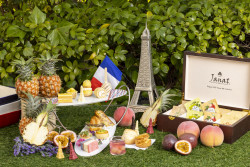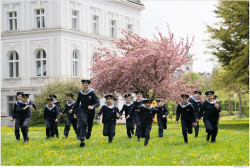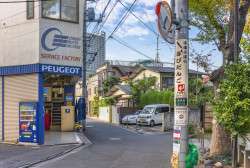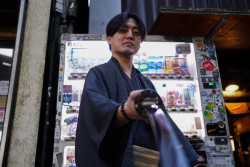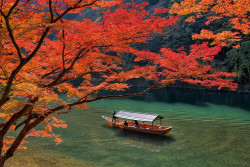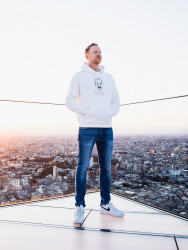
Originally published on metropolis.co.jp on October 2006

Photos by Tabitha Miles
Behind the tranquil façade of every ryokan is a tireless team of workers. Like stagehands in the wings of an elaborate piece of theater, their aim is to anticipate the every need of the persons on stage—in this case, their guests—while remaining, as much as possible, invisible. Directing these people, many of whom dedicate their lives to such service, is one person: the okami.
The “landlady” of a ryokan is the personification of Japanese-style hospitality. For many, the job has been handed down from mother to daughter through the generations. Now, 25 okami from the leading ryokan on the Izu Peninsula have grouped together to promote their inns and preserve their traditions, a group they have called simply The Okami. With a website and online reservations system in English, they want to encourage non-Japanese guests to experience one of Japan’s true pleasures.
The Ikona Ryokan is typical of The Okami’s properties, and its soft-spoken but sharp-minded landlady, Fusako Yoshida, is the fourth-generation owner (and a fluent English speaker). Her hotel is situated in the sleepy village of Shimogamo, a spa town of a thousand people near the southernmost tip of the peninsula. It’s an area that offers some of the best hot springs in the country, as well as the prettiest white sand beaches within reach of Tokyo. It is also seven minutes drive from Yumigahama beach, awarded the curious accolade of “best sounding waves in Japan.”

The 70-year-old Ikona is a traditional place that offers attentive yet non-intrusive service and a retreat from the world when you need a little “me time.” In fact many of its regular clientele over the years have been writers and professors in search of peace. There is very little to do at a ryokan, and that is part of the appeal.
The 42-room hotel is set amid a carefully tended garden that includes 80 varieties of camellias. These lend their names to the rooms, some built to resemble individual cottages with private outdoor hot baths and minimalist stone gardens. If you don’t like nature then you soon will. At night, some of the outdoor baths become a popular spot with hot-spring loving racoons and, bizarrely, crabs of all sizes can be spotted roaming in the public areas.
The cuisine is a highlight at most ryokan, and the Ikona is no exception. Dinner is served either in the comfort of your room or in public at one of the traditional tatami mat dining rooms. Lobster sashimi with seasonal delicacies including duck’s liver blended with chestnut purée are just two items from a 20-item course menu.
After dinner, there is a karaoke lounge, popular with visiting groups of middle-aged men wearing yukata, belting out ‘60s Japanese pop songs while effectively dressed for bed. If that’s not your scene, sit at the bar and treat yourself to hollowed-out halves of ultra-premium melon—originally grown by the okami’s ancestors for the emperor himself—swimming in premium whiskey.
Before bed, a massage from the fiery, middle-aged masseuse is not to be missed. Your aches will vanish, you’ll sleep like a baby, and you’ll discover a whole new universe of pain.
Alternatively, the outdoor Ginga no Yu, or Milky Way onsen, is open all night, and is named after the stars that can be viewed while wallowing in the mineral-rich salty water. If romantic glimpses of the “old Japan” that travelers endlessly seek do exist, even in passing, this is one of those moments.
The Okami’s homepage (www.the-okami.jp) lists details of all 25 member ryokan with a reservation form in English, as well as local travel information. The Ikona Ryokan (422 Shimogamo, Minami Izu-cho, Kamo-gun, Shizuoka-ken; Tel: 0558-62-0030. www.ikona-spa.com) is a 15-minute taxi ride from Shimoda station. Basic rooms start at ¥20,000 per person, including breakfast and dinner. The garden rooms, which have private onsen, begin at ¥30,000 per person, with a single occupancy supplement of ¥15,000. The fastest way to get to Shimoda is by shinkansen from Tokyo or Shinagawa to Atami, then by express on the Ito line to Shimoda (¥5,970, approx. 2 hours). The easiest is by direct limited express from Tokyo or Shinjuku to Shimoda (¥6,460, approx. 2.5 hours). Attractions in Shimoda include Ryosenji temple, where US Commodore Matthew Perry negotiated the opening of Japan to foreign trade in the 1850s, and the delightful “Perry Road,” lined with trees and historic buildings, some decorated with the local black and white diamond pattern. Suzukatsu Doll (2-10-26 Shimoda; 0558-22-0766) stocks handmade Japanese dolls of the kind given to young girls on their coming-of-age birthdays and costing as much as ¥65,000 each. Nearby, Nishindo (3-3-7 Shimoda, 0558-22-2263) has been selling Madeleine sponge cakes for 60 years, and was a favorite of Yukio Mishima. At Gallery & Café Sogabo (3-14-6 Shichikenchiyo; 0558-27-1123), located inside an old wooden Japanese home, the owner commissions local potters to create bowls and plates which she paints in simple Japanese brushstrokes. Shimoda’s seafood is even better than Tokyo’s, so make a point of having a large, cheap sashimi lunch.
[geo_mashup_map]
